-
 Class In History Second Floor - Room 49.
Class In History Second Floor - Room 49. This image depicts a history class being taught by Florence Shultes, an instructor in the History and Civil Government department. One of the conditions of admission into the Normal school was that students were required to have knowledge of the significant elements of American history and be able to express critical thinking skills. This is made evident in the 1893-94 Normal register when it states, “History furnishes material for judgements, and unless the pupil has learned to see the relations between the facts, to compare, to judge, that is to think, to use the facts, he is not ready for any such study as Political History.” (p.56)
-
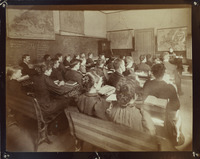 Class in History Second Floor - Room 48, Mary Putnam
Class in History Second Floor - Room 48, Mary Putnam This image depicts a History class being taught by Mary Putnam, who is sitting behind the desk at the head of the room. The History curriculum at the Normal school focused heavily on the history of the Western world, with American and English history being prioritized. The Normal’s General History coursework focused heavily on Greek and Roman history, and the extent to which the history of non-Western cultures were covered is not discussed in the course description. Much of the discussion relating to non-Western societies appears to have been relegated to the Geography department.
-
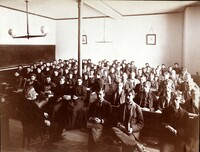 Class in History of Education First Floor - Room 2.
Class in History of Education First Floor - Room 2. This image depicts a class called The History of Education being taught by Daniel Putnam, who taught the Theory of Art and Teaching courses in addition to psychology courses. This class only took half of one semester to complete and focused on the history of schools, school systems, and education in general. To help students understand how the field of education had progressed, Putnam taught about great educational leaders of both the past and the present.
-
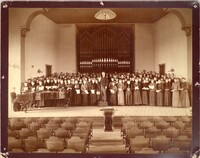 Choir standing behind Director Frederic Pease
Choir standing behind Director Frederic Pease This image depicts the Normal Choir standing behind Director, Frederic Pease, on the stage of the auditorium on the third floor of Old Main. The Normal chorus generally consisted of about one hundred and fifty voices, who would meet daily for one-and-a-half-hour rehearsals. The work in The Normal Choir consisted of preparing music to perform at public school exercises and concerts that would be given throughout the year. The choir also assisted in leading worship during the daily Chapel Exercises that took place in the Normal Hall every morning at 8:20.
-
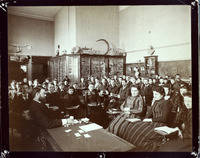 Biological Lecture Room 3rd floor - Room 58.
Biological Lecture Room 3rd floor - Room 58. This image depicts a lecture being given by William H. Sherzer, who taught courses relating to Structural Botany, Zoology, and Geology. While this room is identified as the “biological lecture room”, the only course with “biology” or “biological” in its name was Biological Technics, a laboratory course that taught students how to properly handle animal and plant specimens “for purposes of study and illustration.” This class also taught students how to skin and mount birds and small mammals, as well as, clean and articulate skeletons, evidence of which can be seen in and on top of the cabinets in the back of the room. In the late 19th century, the Normal had a collection of over 1000 animal specimens and 2000+ insect specimens.
-
 Biological Laboratory 3rd Floor - Room 59.
Biological Laboratory 3rd Floor - Room 59. This image depicts students working in the biological laboratory taken during the winter of the 1892-93 school year. The Normal had 66 microscopes in total (36 compounds and 30 dissecting), many of which can be seen being used by students in the photograph. To prepare microscopic specimens for use in the dissecting microscopes, the lab was stocked with a single microtome, a precision cutting instrument that produces extremely thin slices of various biological materials. The Normal had a Thoma and Minot brand microtome (invented in 1886), that was the most advanced microtome available on the market in the late 19th century.
-
 Athenaeum Society First Floor -Room 6.
Athenaeum Society First Floor -Room 6. This image depicts another of the clubs that was organized under the Lyceum constitution, the Athenaeum Society. All four of the literary societies had a limit of 60 members, and membership was usually full. According to the 1893 Aurora, the Atheneum was “the most conveniently and finely furnished of the societies, and out of debt.” This student organization prided itself on its weekly programs. In 1893, when this photograph was taken, five out of the eight Normal students who were given commencement honors were members of the Atheneum Society (pg.81).
-
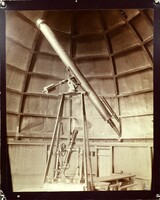 Alvan Clark refractor telescope located in the third floor Observatory - Room 59.
Alvan Clark refractor telescope located in the third floor Observatory - Room 59. This image depicts the Alvan Clark refractor telescope (large), and the Brandis transit telescope (small). The Alvan Clark 4'' refractor telescope, purchased in 1872 for about $300; Brandis transit telescope purchased in 1876 for $680.00 (small scope sitting under larger telescope). Both of these telescopes were placed in the observatory dome after construction was completed in 1881. In 1893 a tornado carried the observatory dome twenty-five feet, and while both of the telescopes were able to be repaired after the disaster the Brandis was unfortunately lost in the Sherzer Hall fire of 1989. About half of Sherzer was gutted during the fire, marking it one of the most devastating events in our university’s history. The Alvan Clark telescope is currently housed in the Sherzer Observatory.
-
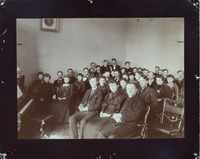 Adelphic Society Second Floor - Room 39.
Adelphic Society Second Floor - Room 39. The image depicts a meeting of the Adelphic Society, another of the Lyceum Societies created during the reorganization in 1881. The motto of this society was “Vita sine litteris mors est” which roughly translates to “Life without literature is death.” The purpose of the Adelphic Society was to combine culture with recreation. As such, the Adelphics meeting room was, in 1891, furnished with a piano as well as other necessities to be used for entertainment purposes (musicals and plays).
 Class In History Second Floor - Room 49. This image depicts a history class being taught by Florence Shultes, an instructor in the History and Civil Government department. One of the conditions of admission into the Normal school was that students were required to have knowledge of the significant elements of American history and be able to express critical thinking skills. This is made evident in the 1893-94 Normal register when it states, “History furnishes material for judgements, and unless the pupil has learned to see the relations between the facts, to compare, to judge, that is to think, to use the facts, he is not ready for any such study as Political History.” (p.56)
Class In History Second Floor - Room 49. This image depicts a history class being taught by Florence Shultes, an instructor in the History and Civil Government department. One of the conditions of admission into the Normal school was that students were required to have knowledge of the significant elements of American history and be able to express critical thinking skills. This is made evident in the 1893-94 Normal register when it states, “History furnishes material for judgements, and unless the pupil has learned to see the relations between the facts, to compare, to judge, that is to think, to use the facts, he is not ready for any such study as Political History.” (p.56) Class in History Second Floor - Room 48, Mary Putnam This image depicts a History class being taught by Mary Putnam, who is sitting behind the desk at the head of the room. The History curriculum at the Normal school focused heavily on the history of the Western world, with American and English history being prioritized. The Normal’s General History coursework focused heavily on Greek and Roman history, and the extent to which the history of non-Western cultures were covered is not discussed in the course description. Much of the discussion relating to non-Western societies appears to have been relegated to the Geography department.
Class in History Second Floor - Room 48, Mary Putnam This image depicts a History class being taught by Mary Putnam, who is sitting behind the desk at the head of the room. The History curriculum at the Normal school focused heavily on the history of the Western world, with American and English history being prioritized. The Normal’s General History coursework focused heavily on Greek and Roman history, and the extent to which the history of non-Western cultures were covered is not discussed in the course description. Much of the discussion relating to non-Western societies appears to have been relegated to the Geography department. Class in History of Education First Floor - Room 2. This image depicts a class called The History of Education being taught by Daniel Putnam, who taught the Theory of Art and Teaching courses in addition to psychology courses. This class only took half of one semester to complete and focused on the history of schools, school systems, and education in general. To help students understand how the field of education had progressed, Putnam taught about great educational leaders of both the past and the present.
Class in History of Education First Floor - Room 2. This image depicts a class called The History of Education being taught by Daniel Putnam, who taught the Theory of Art and Teaching courses in addition to psychology courses. This class only took half of one semester to complete and focused on the history of schools, school systems, and education in general. To help students understand how the field of education had progressed, Putnam taught about great educational leaders of both the past and the present. Choir standing behind Director Frederic Pease This image depicts the Normal Choir standing behind Director, Frederic Pease, on the stage of the auditorium on the third floor of Old Main. The Normal chorus generally consisted of about one hundred and fifty voices, who would meet daily for one-and-a-half-hour rehearsals. The work in The Normal Choir consisted of preparing music to perform at public school exercises and concerts that would be given throughout the year. The choir also assisted in leading worship during the daily Chapel Exercises that took place in the Normal Hall every morning at 8:20.
Choir standing behind Director Frederic Pease This image depicts the Normal Choir standing behind Director, Frederic Pease, on the stage of the auditorium on the third floor of Old Main. The Normal chorus generally consisted of about one hundred and fifty voices, who would meet daily for one-and-a-half-hour rehearsals. The work in The Normal Choir consisted of preparing music to perform at public school exercises and concerts that would be given throughout the year. The choir also assisted in leading worship during the daily Chapel Exercises that took place in the Normal Hall every morning at 8:20. Biological Lecture Room 3rd floor - Room 58. This image depicts a lecture being given by William H. Sherzer, who taught courses relating to Structural Botany, Zoology, and Geology. While this room is identified as the “biological lecture room”, the only course with “biology” or “biological” in its name was Biological Technics, a laboratory course that taught students how to properly handle animal and plant specimens “for purposes of study and illustration.” This class also taught students how to skin and mount birds and small mammals, as well as, clean and articulate skeletons, evidence of which can be seen in and on top of the cabinets in the back of the room. In the late 19th century, the Normal had a collection of over 1000 animal specimens and 2000+ insect specimens.
Biological Lecture Room 3rd floor - Room 58. This image depicts a lecture being given by William H. Sherzer, who taught courses relating to Structural Botany, Zoology, and Geology. While this room is identified as the “biological lecture room”, the only course with “biology” or “biological” in its name was Biological Technics, a laboratory course that taught students how to properly handle animal and plant specimens “for purposes of study and illustration.” This class also taught students how to skin and mount birds and small mammals, as well as, clean and articulate skeletons, evidence of which can be seen in and on top of the cabinets in the back of the room. In the late 19th century, the Normal had a collection of over 1000 animal specimens and 2000+ insect specimens. Biological Laboratory 3rd Floor - Room 59. This image depicts students working in the biological laboratory taken during the winter of the 1892-93 school year. The Normal had 66 microscopes in total (36 compounds and 30 dissecting), many of which can be seen being used by students in the photograph. To prepare microscopic specimens for use in the dissecting microscopes, the lab was stocked with a single microtome, a precision cutting instrument that produces extremely thin slices of various biological materials. The Normal had a Thoma and Minot brand microtome (invented in 1886), that was the most advanced microtome available on the market in the late 19th century.
Biological Laboratory 3rd Floor - Room 59. This image depicts students working in the biological laboratory taken during the winter of the 1892-93 school year. The Normal had 66 microscopes in total (36 compounds and 30 dissecting), many of which can be seen being used by students in the photograph. To prepare microscopic specimens for use in the dissecting microscopes, the lab was stocked with a single microtome, a precision cutting instrument that produces extremely thin slices of various biological materials. The Normal had a Thoma and Minot brand microtome (invented in 1886), that was the most advanced microtome available on the market in the late 19th century. Athenaeum Society First Floor -Room 6. This image depicts another of the clubs that was organized under the Lyceum constitution, the Athenaeum Society. All four of the literary societies had a limit of 60 members, and membership was usually full. According to the 1893 Aurora, the Atheneum was “the most conveniently and finely furnished of the societies, and out of debt.” This student organization prided itself on its weekly programs. In 1893, when this photograph was taken, five out of the eight Normal students who were given commencement honors were members of the Atheneum Society (pg.81).
Athenaeum Society First Floor -Room 6. This image depicts another of the clubs that was organized under the Lyceum constitution, the Athenaeum Society. All four of the literary societies had a limit of 60 members, and membership was usually full. According to the 1893 Aurora, the Atheneum was “the most conveniently and finely furnished of the societies, and out of debt.” This student organization prided itself on its weekly programs. In 1893, when this photograph was taken, five out of the eight Normal students who were given commencement honors were members of the Atheneum Society (pg.81). Alvan Clark refractor telescope located in the third floor Observatory - Room 59. This image depicts the Alvan Clark refractor telescope (large), and the Brandis transit telescope (small). The Alvan Clark 4'' refractor telescope, purchased in 1872 for about $300; Brandis transit telescope purchased in 1876 for $680.00 (small scope sitting under larger telescope). Both of these telescopes were placed in the observatory dome after construction was completed in 1881. In 1893 a tornado carried the observatory dome twenty-five feet, and while both of the telescopes were able to be repaired after the disaster the Brandis was unfortunately lost in the Sherzer Hall fire of 1989. About half of Sherzer was gutted during the fire, marking it one of the most devastating events in our university’s history. The Alvan Clark telescope is currently housed in the Sherzer Observatory.
Alvan Clark refractor telescope located in the third floor Observatory - Room 59. This image depicts the Alvan Clark refractor telescope (large), and the Brandis transit telescope (small). The Alvan Clark 4'' refractor telescope, purchased in 1872 for about $300; Brandis transit telescope purchased in 1876 for $680.00 (small scope sitting under larger telescope). Both of these telescopes were placed in the observatory dome after construction was completed in 1881. In 1893 a tornado carried the observatory dome twenty-five feet, and while both of the telescopes were able to be repaired after the disaster the Brandis was unfortunately lost in the Sherzer Hall fire of 1989. About half of Sherzer was gutted during the fire, marking it one of the most devastating events in our university’s history. The Alvan Clark telescope is currently housed in the Sherzer Observatory. Adelphic Society Second Floor - Room 39. The image depicts a meeting of the Adelphic Society, another of the Lyceum Societies created during the reorganization in 1881. The motto of this society was “Vita sine litteris mors est” which roughly translates to “Life without literature is death.” The purpose of the Adelphic Society was to combine culture with recreation. As such, the Adelphics meeting room was, in 1891, furnished with a piano as well as other necessities to be used for entertainment purposes (musicals and plays).
Adelphic Society Second Floor - Room 39. The image depicts a meeting of the Adelphic Society, another of the Lyceum Societies created during the reorganization in 1881. The motto of this society was “Vita sine litteris mors est” which roughly translates to “Life without literature is death.” The purpose of the Adelphic Society was to combine culture with recreation. As such, the Adelphics meeting room was, in 1891, furnished with a piano as well as other necessities to be used for entertainment purposes (musicals and plays).